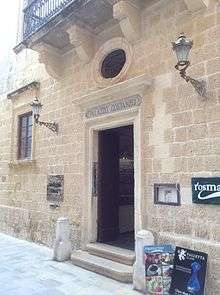Mdina
| Mdina L-Imdina Città Notabile, Città Vecchia Melita | |||
|---|---|---|---|
| City and Local council | |||
|
| |||
| |||
| Nickname(s): The Silent City | |||
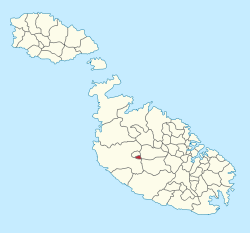 | |||
| Coordinates: 35°53′9″N 14°24′11″E / 35.88583°N 14.40306°ECoordinates: 35°53′9″N 14°24′11″E / 35.88583°N 14.40306°E | |||
| Country |
| ||
| Region | Northern Region | ||
| District | Western District | ||
| Established | c. 700 BC | ||
| Founded by | Phoenicians | ||
| Borders | Attard, Mtarfa, Rabat | ||
| Government | |||
| • Mayor | Peter Dei Conti Sant Manduca (PN) | ||
| Area | |||
| • Total | 0.9 km2 (0.3 sq mi) | ||
| Population (March 2014) | |||
| • Total | 292 | ||
| • Density | 320/km2 (840/sq mi) | ||
| Demonym(s) | Midjan (m), Midjana (f), Midjani (p) | ||
| Time zone | CET (UTC+1) | ||
| • Summer (DST) | CEST (UTC+2) | ||
| Postal code | MDN | ||
| Dialing code | 356 | ||
| ISO 3166 code | MT-29 | ||
| Patron saint |
St. Peter St. Paul Our Lady of Mount Carmel | ||
| Day of festa |
29 June 4th Sunday of July | ||
| Website | Official website | ||
| Buses 50, 51, 52, 53, 56 from Valletta terminus, stop at bus stop named "Rabat 3" [1] | |||
Mdina (English: Notabile, or Maltese: L-Imdina [lɪmˈdɪnɐ]; Phoenician: 𐤌𐤋𐤉𐤈𐤄, Melitta, Ancient Greek: Melitte, Μελίττη, Arabic: Madinah, لمدينة), also known by its titles Città Vecchia or Città Notabile, is a fortified city in the Northern Region of Malta, which served as the island's capital from antiquity to the medieval period. The city is still confined within its walls, and has a population of just under 300, but it is contiguous with the town of Rabat, which takes its name from the Arabic word for suburb, and has a population of over 11,000.[2]
The city was founded as Maleth in around 700 BC by Phoenician settlers, and was later renamed Melite by the Romans. Ancient Melite was larger than present-day Mdina, and it was reduced to its present size during the Byzantine or Arab occupation of Malta. During the latter period, the city adopted its present name, which derives from the Arabic word medina. The city remained the capital of Malta throughout the Middle Ages, until the arrival of the Order of St. John in 1530, when Birgu became the administrative centre of the island. Mdina experienced a period of decline over the following centuries, although it saw a brief revival in the early 18th century when it acquired several Baroque features, although it did not lose its medieval character.
Mdina remained the centre of the Maltese nobility and religious authorities, but it never regained its pre-1530 importance, giving rise to the popular nickname the "Silent City" by both locals and visitors.[3] Mdina is on the tentative list of UNESCO World Heritage Sites, and it is now one of the main tourist attractions in Malta.[4]
History

Antiquity
Evidence of settlements in Mdina goes back to before 4000 BC. It was possibly first fortified by the [Phoenicians] around 700 BC, because of its strategic location on one of the highest points on the island and as far from the sea as possible. When Malta had been under the control of the Roman Empire, the Roman Governor built his palace there. Legend has it that it was here, in around 60 CE, that Paul the Apostle lived after his shipwreck on the islands.
Medieval period
In 870 AD, Byzantine Melite, which was ruled by governor Amros (probably Ambrosios), was besieged by Aghlabids led by Halaf al-Hādim. He was killed in the fighting, and Sawāda Ibn Muḥammad was sent from Sicily to continue the siege following his death. The duration of the siege is unknown, but it probably lasted for some weeks or months. After Melite fell to the invaders, the inhabitants were massacred, the city was destroyed and its churches were looted. Marble from Melite's churches was used to build the castle of Sousse. The city was rebuilt as Medina when Muslims resettled in Malta in 1048–49, and according to Al-Himyarī, "it became a finer place than it was before." In around 1053–54, the Byzantines besieged Medina but they were repelled by its defenders.[5] The present layout of the city still has features typical of a medina, a legacy of the period of Arab rule.
Malta was conquered by the Normans in 1091. In 1429, Hafsid Saracens attempted to take the city but were repelled by its defenders.[6]
Hospitaller rule
When the Order of Saint John arrived in Malta on 26 October 1530, Grandmaster Philippe Villiers de L'Isle-Adam promised to uphold the rights of the Maltese people, and was given the keys of Mdina. The Order went on to settle in Birgu, and Mdina lost its status as capital city. The nobility of Mdina were rather hostile to the Order since they lost most of their power over the rest of the population.[7] The medieval fortifications of Mdina were upgraded during the reign of Juan de Homedes y Coscon, and the city withstood a brief Ottoman attack in 1551. At the end of the Great Siege of Malta of 1565, the defenders of Mdina scared away the Ottoman army that was retreating from their failed siege of the Order's base in the Grand Harbour by firing their cannons, despite having very little ammunition. Mdina's fortifications were again upgraded in the 17th century, when the large De Redin Bastion was built.
The city was severely damaged by the 1693 Sicily earthquake, and a large number of buildings were destroyed. After the earthquake, the cathedral was demolished and rebuilt on the designs of the Maltese architect Lorenzo Gafà. Mdina was extensively restored in the course of the eighteenth century, and Baroque elements were introduced in the largely medieval city.[8] Plans were made to strengthen the city with more fortifications but these were never implemented as the Order focused on the fortifications at the harbour area.[9]
French occupation and British rule

Mdina was briefly occupied by French forces from June 1798. French rule did not last long because Mdina was taken over by Maltese rebels on 2 September 1798. This event marked the beginning of a two-year uprising and blockade of French forces in Malta's harbour area, by Maltese insurgents aided by British, Neapolitan and Portuguese troops. Mdina was an important base for the Maltese insurgents during the blockade.
Mdina was linked to the present capital Valletta with the Malta Railway from 1883 to 1931.
Present day
Today, no cars (other than a limited number of residents, emergency vehicles, wedding cars and hearses) are allowed in Mdina, partly why it has earned the nickname 'the Silent City'. The city displays an unusual mix of Norman and Baroque architecture, including several palaces, most of which serve as private homes.
The city's fortifications began to be restored in 2008 and restoration was expected to be complete by July 2015.[10][11]
Places of interest
- The city walls, including Mdina Gate, Greeks Gate and the Torre dello Standardo
- St. Paul's Cathedral
- Palazzo Vilhena (National Museum of Natural History)
- Palazzo Falson (Norman House)
- Palazzo Gatto Murina
- Palazzo Santa Sofia
- Palazzo Costanzo
- Banca Giuratale
- Corte Capitanale (city hall)
- St. Agatha's Chapel
- St. Nicholas' Chapel
- Mdina Dungeons
- Carmelite Church & Convent
- Mdina Experience
- Benedictine Monastery
- Bastion Square
- Domvs Romana, ruins of a Roman townhouse just outside the city
Sports
Founded in 2006, the Mdina Knights are currently enjoying a positive moment in the third division league organised by Malta's football governing body, the Malta Football Association.
Streets in Mdina

- Misraħ il-Kunsill Ċittà Notabile (Notabile City Council Square)
- Piazza San Pawl (St Paul Square)
- Piazza San Publiju (St Publius Square)
- Piazza tal-Arċisqof (Archbishop Square)
- Piazza tas-Sur (Bastion Square)
- Piazzetta Beata Marija Adeodata Pisani (Blessed Maria Adeodata Pisani Square)
- Triq Inguanez (Inguanez Street)
- Triq is-Sur (Bastion Street)
- Triq San Pawl (St Paul Street)
- Triq Santu Rokku (St Roch Street)
- Triq Villegaignon (Villegaignon Street)
In popular culture
- Mdina (together with Birgu and Gozo) plays a significant role in The Disorderly Knights, the third book of the acclaimed Lymond Chronicles by Dorothy Dunnett, which is set around the events of the Dragut Raid of 1551 when the Ottomans briefly besieged the city.
- In White Wolf Publishing's World of Darkness, Mdina is the European capital of clan Lasombra.
- In the 2007 novel Snakehead by Anthony Horowitz, Mdina is the site of an "ambush" where MI6 intends to retrieve Alex Rider's father John.
- In the first season of HBO's Game of Thrones, Mdina was the filming location for the series' fictional capital city of King's Landing. For the second season, Dubrovnik was used instead.[12]
Gallery
-

Mdina Gate, the city's main entrance,designed by the French architect Charles François de Mondion in 1724.
-
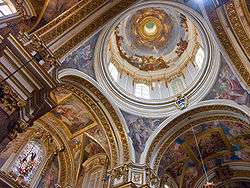
Cathedral's interior
-

Typical narrow medieval street
-

Typical Maltese door in Mdina
-
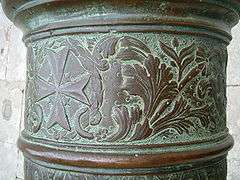
Cannon inscription
-

Traditional medieval Maltese balcony
-

Palazzo de Piro
-

Garden archway
-
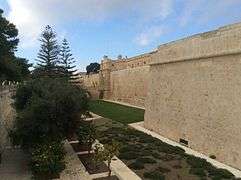
Part of the fortifications of Mdina
-
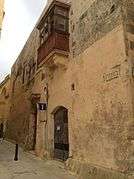
Palazzo Feriol
-

The Maltacom Building
-

Palazzo del Parlato
-
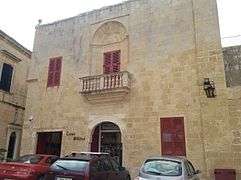
Casa Mdina
References
| Wikimedia Commons has media related to Mdina. |
| Wikivoyage has a travel guide for Mdina. |
- ↑ http://www.publictransport.com.mt/routes
- ↑ "Estimated Population by Locality 31st March, 2014". Government of Malta. 16 May 2014. Archived from the original on 21 June 2015.
- ↑ Craven, John (2 March 2009). "Celebrity travel: Starry knights and three-pin plugs in Malta". Daily Mail. Retrieved 22 March 2010.
- ↑ Blasi, Abigail (29 September 2014). "Top 10 day trips in Malta". Lonely Planet. Archived from the original on 10 October 2015.
- ↑ Brincat, Joseph M. "New Light on the Darkest Age in Malta’s History". melitensiawth.com. Archived from the original (PDF) on 6 June 2015.
- ↑ Cauchi, Mark (12 September 2004). "575th anniversary of the 1429 Siege of Malta". Times of Malta. Retrieved 20 February 2015.
- ↑ Sciberras, Sandro. "A. The Early Years of the Order of St John in Malta" (PDF). St Benedict College. Retrieved 18 April 2015.
- ↑ Sciberras, Sandro. "C. Some of the Order’s Projects in Malta" (PDF). St Benedict College. Retrieved 18 April 2015.
- ↑ "Fortification building spree left Mdina out". The Malta Independent. 30 March 2014. Retrieved 18 April 2015.
- ↑ "Steel rods come to St Paul’s bastions’ rescue". Times of Malta. 6 February 2011. Retrieved 18 April 2015.
- ↑ "Mdina bastions restoration works to continue". Times of Malta. 4 September 2014. Retrieved 18 April 2015.
- ↑ Newton, Jennifer (30 April 2014). "The real-life locations for Game Of Thrones: Stunning locations where TV’s smash hit swords and sorcery show is filmed". Daily Mail. Retrieved 18 April 2015.
| ||||||||||||||||||||
|



.jpg)

